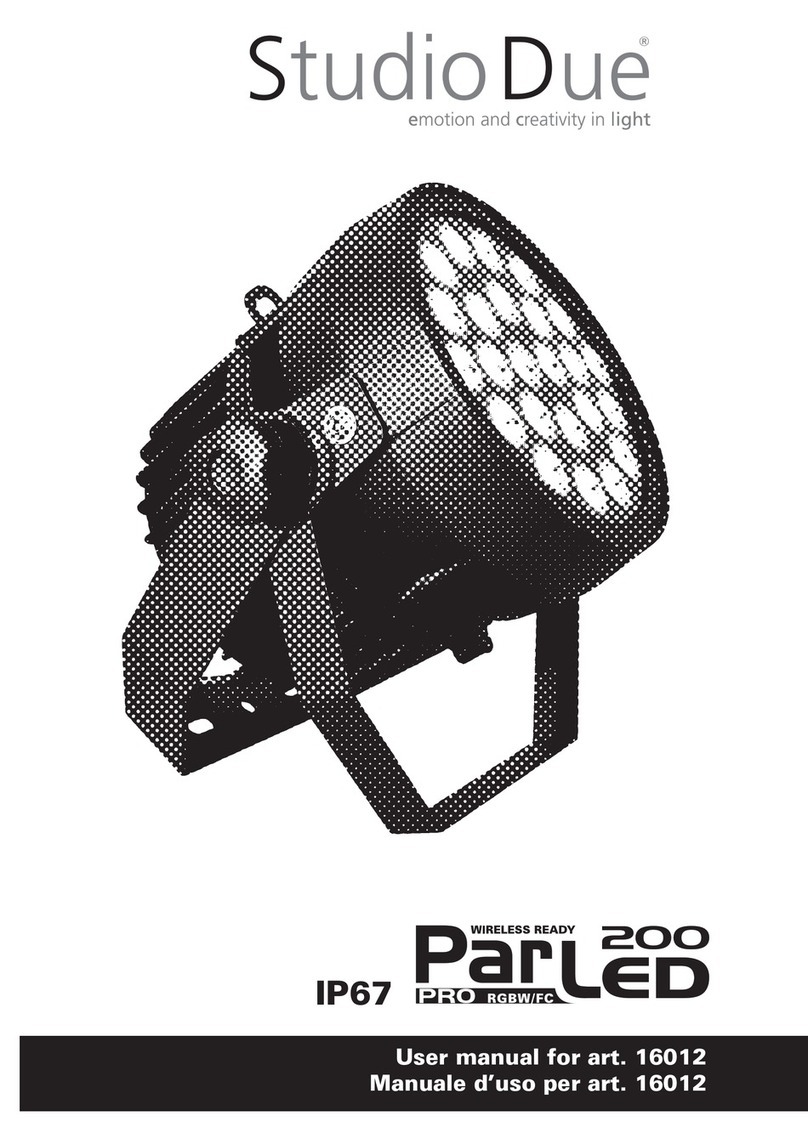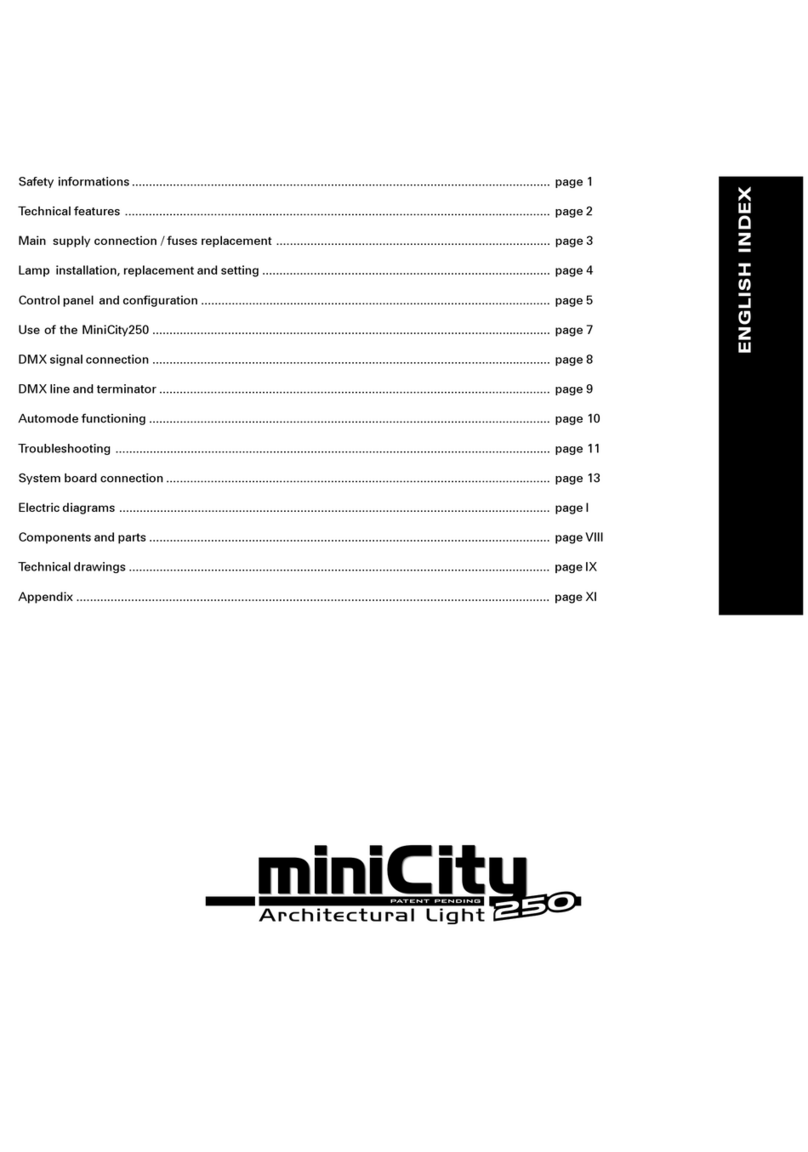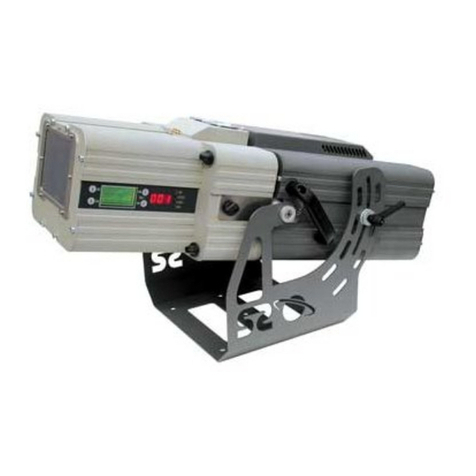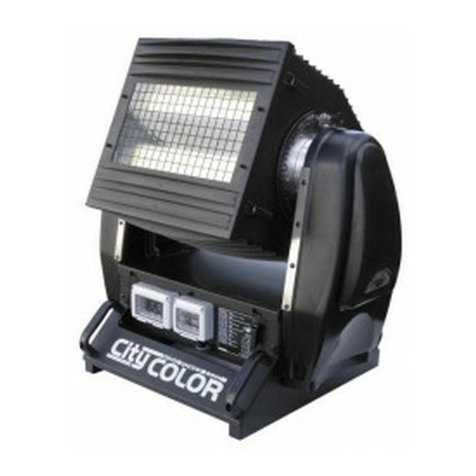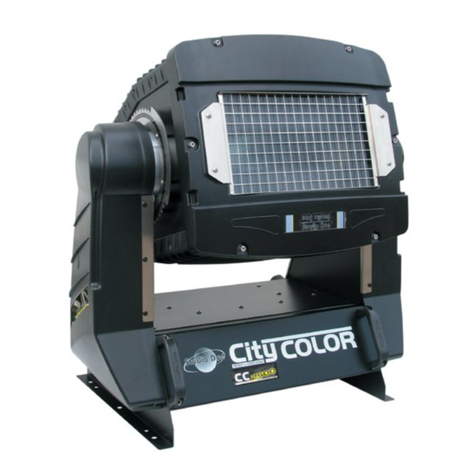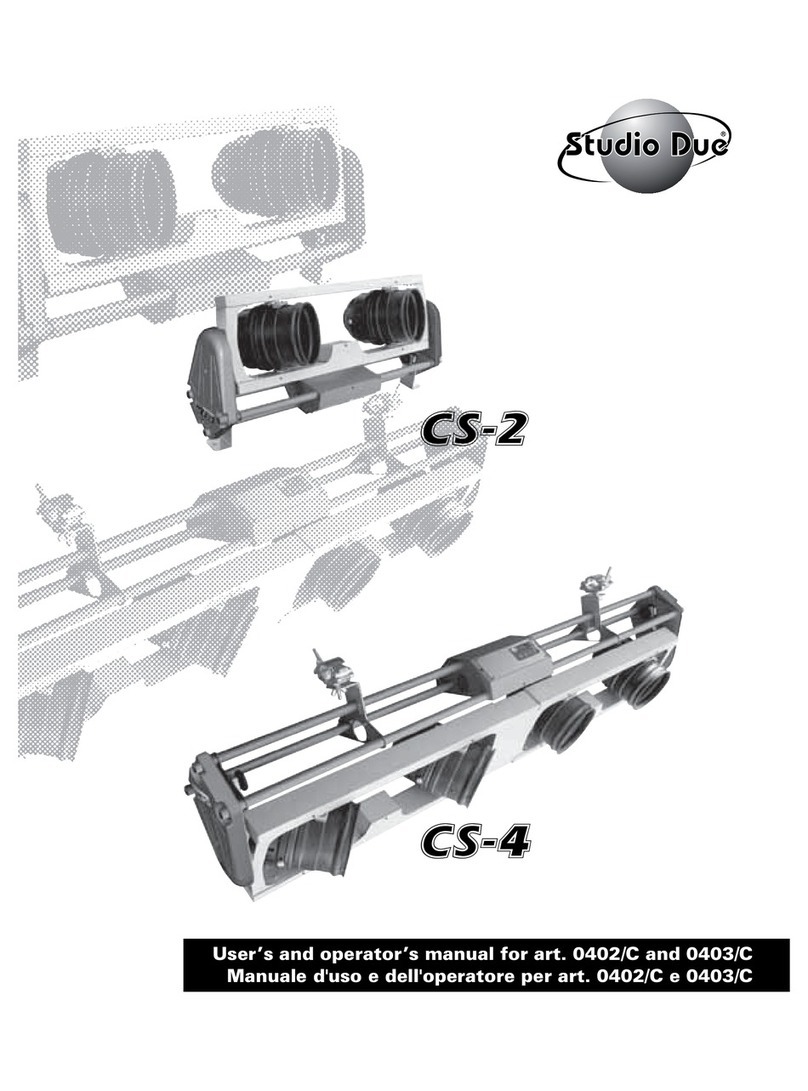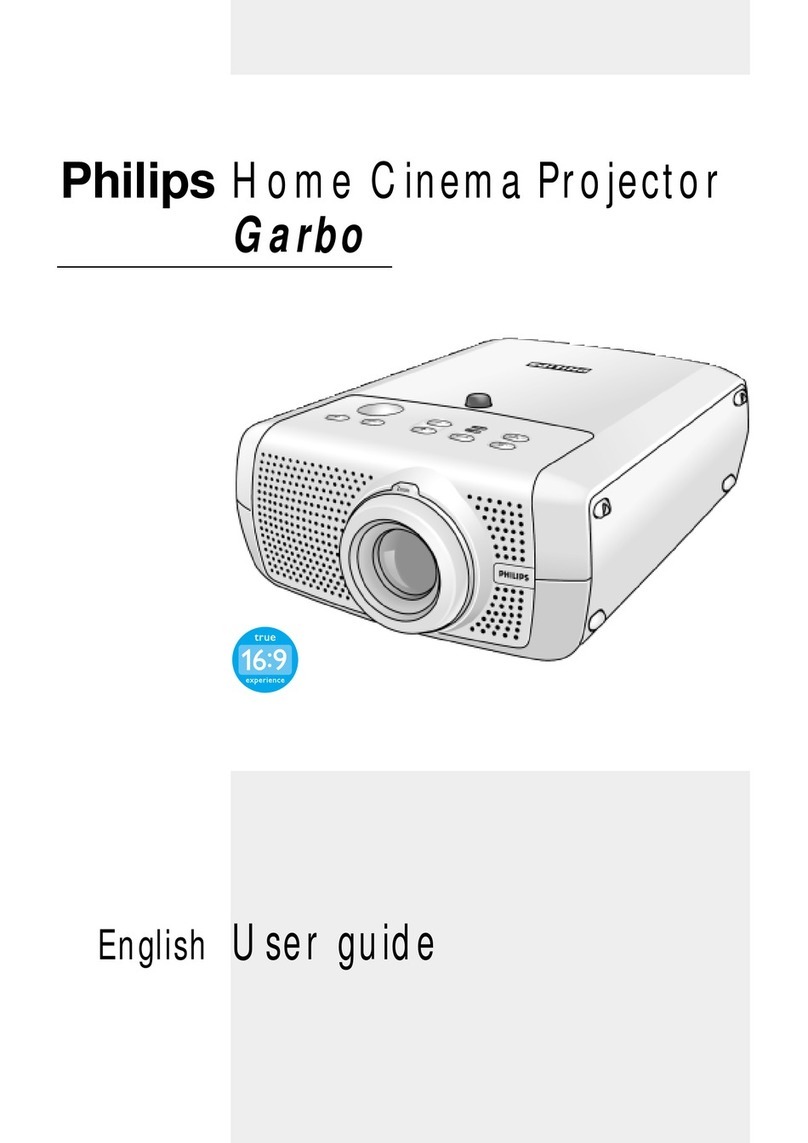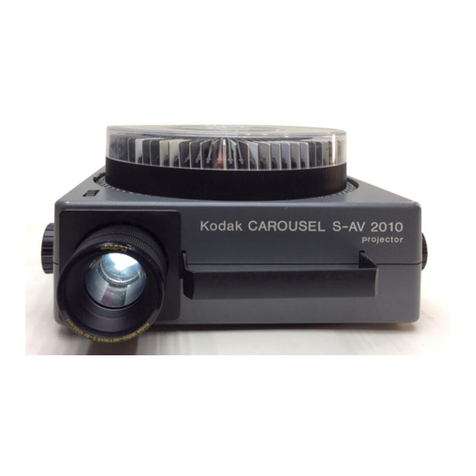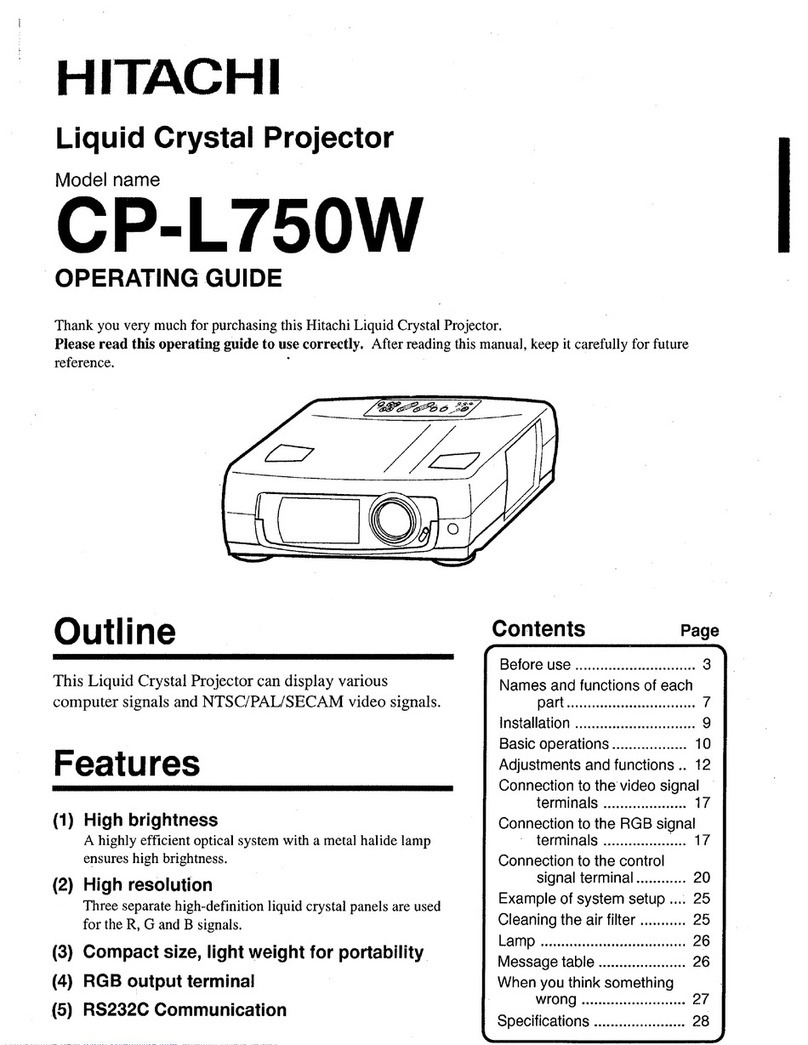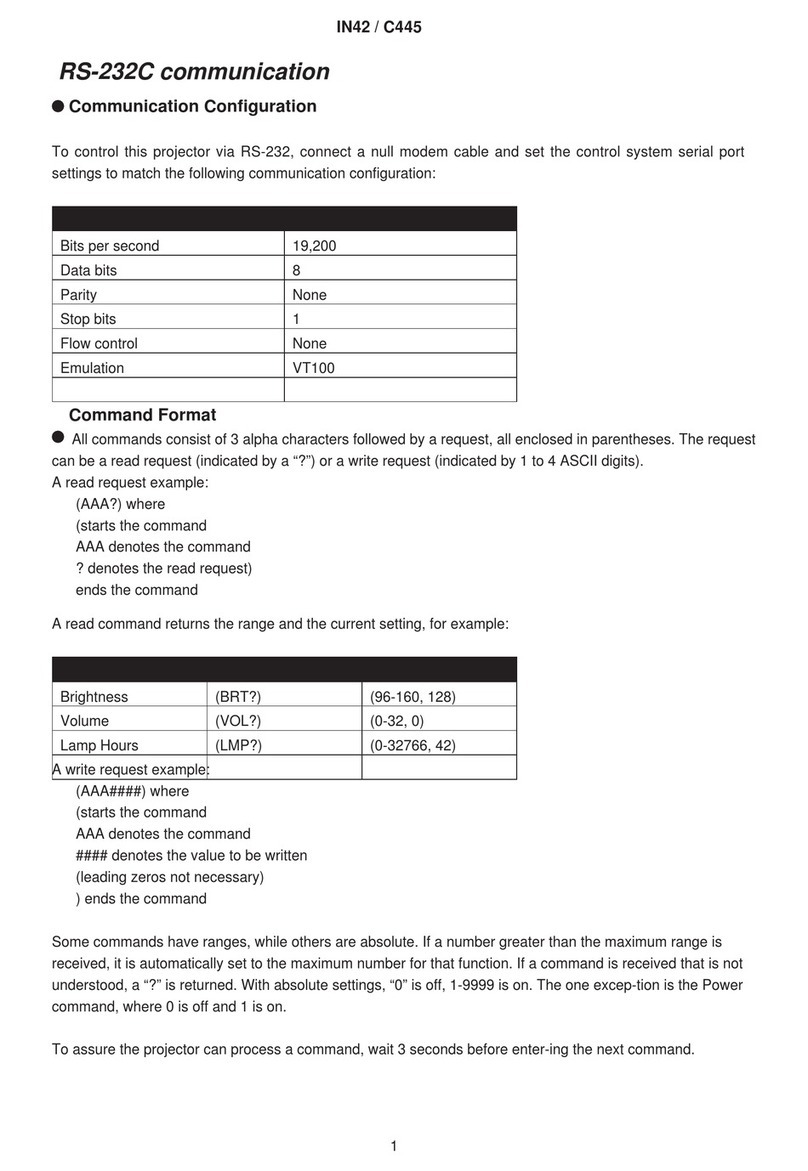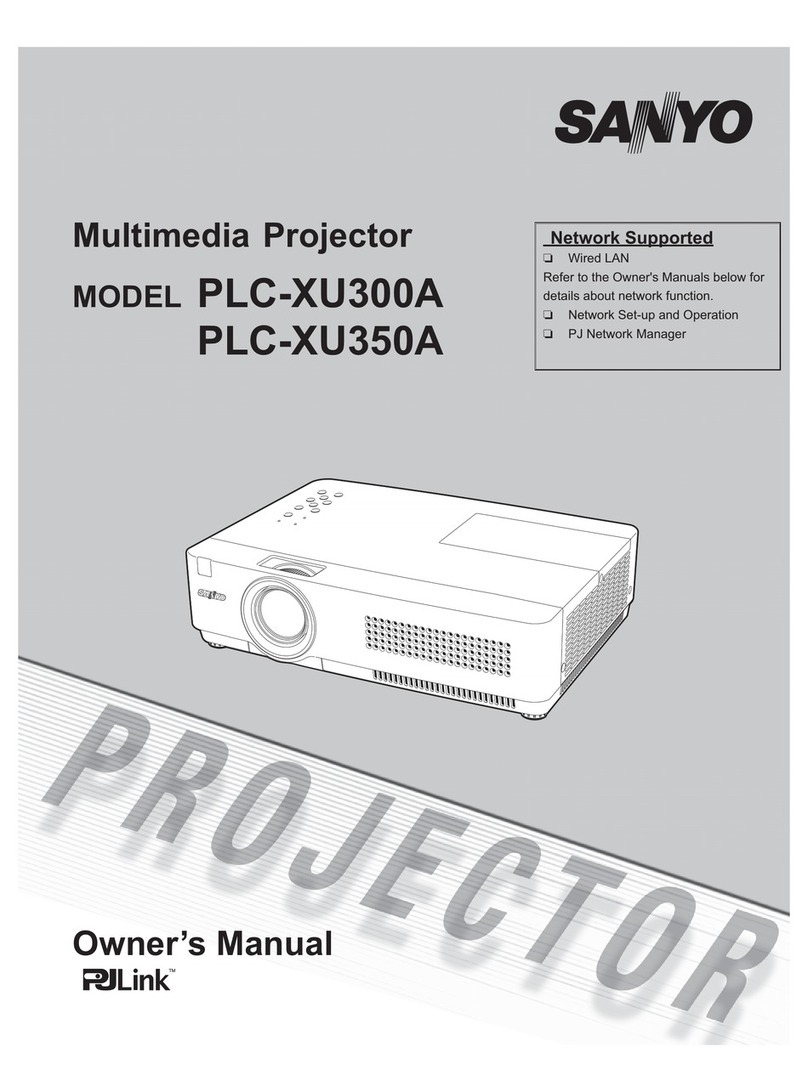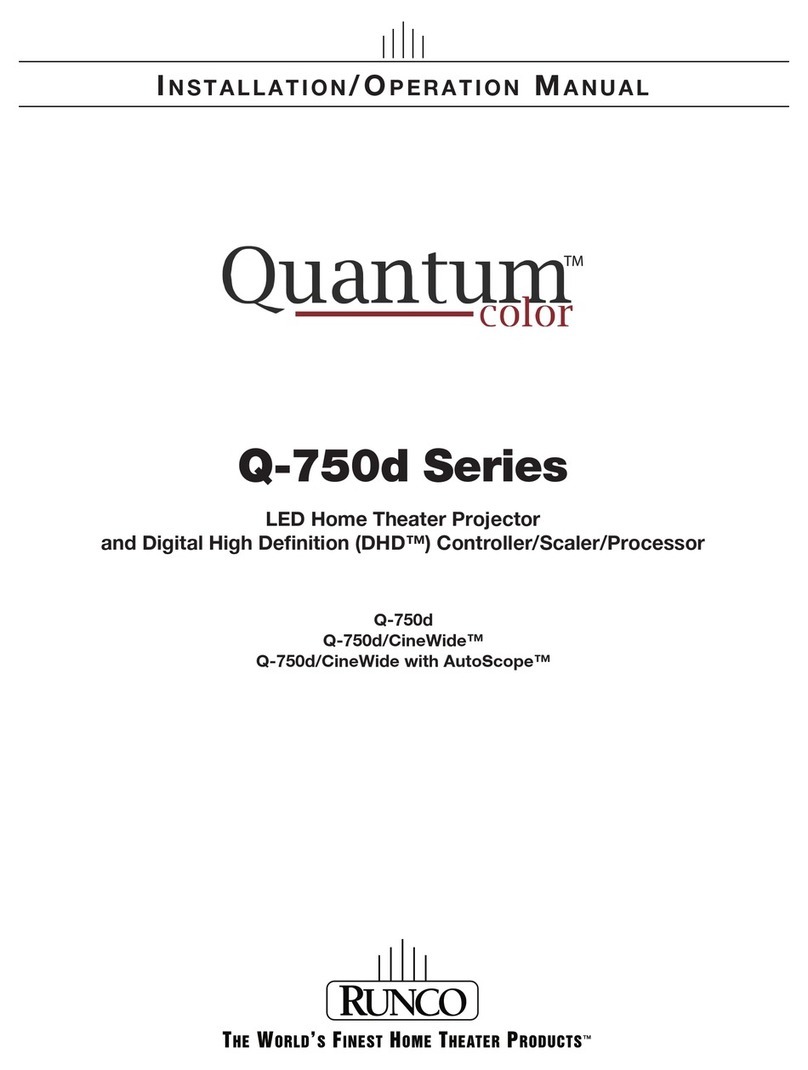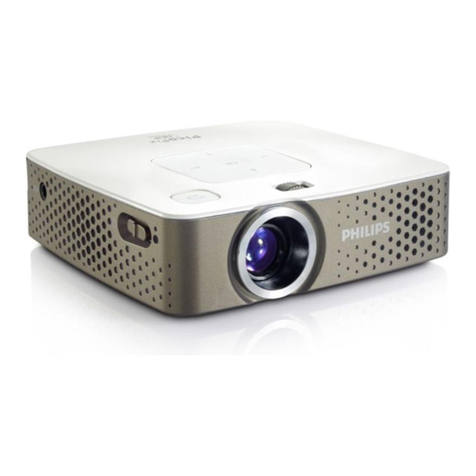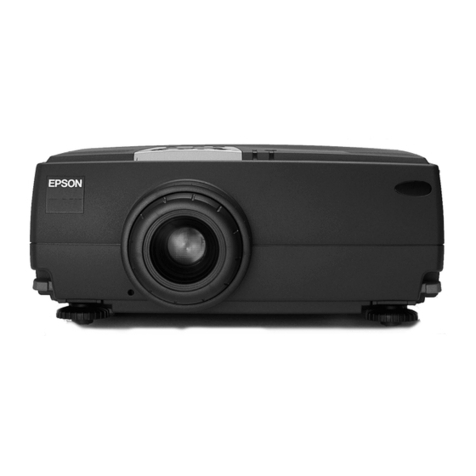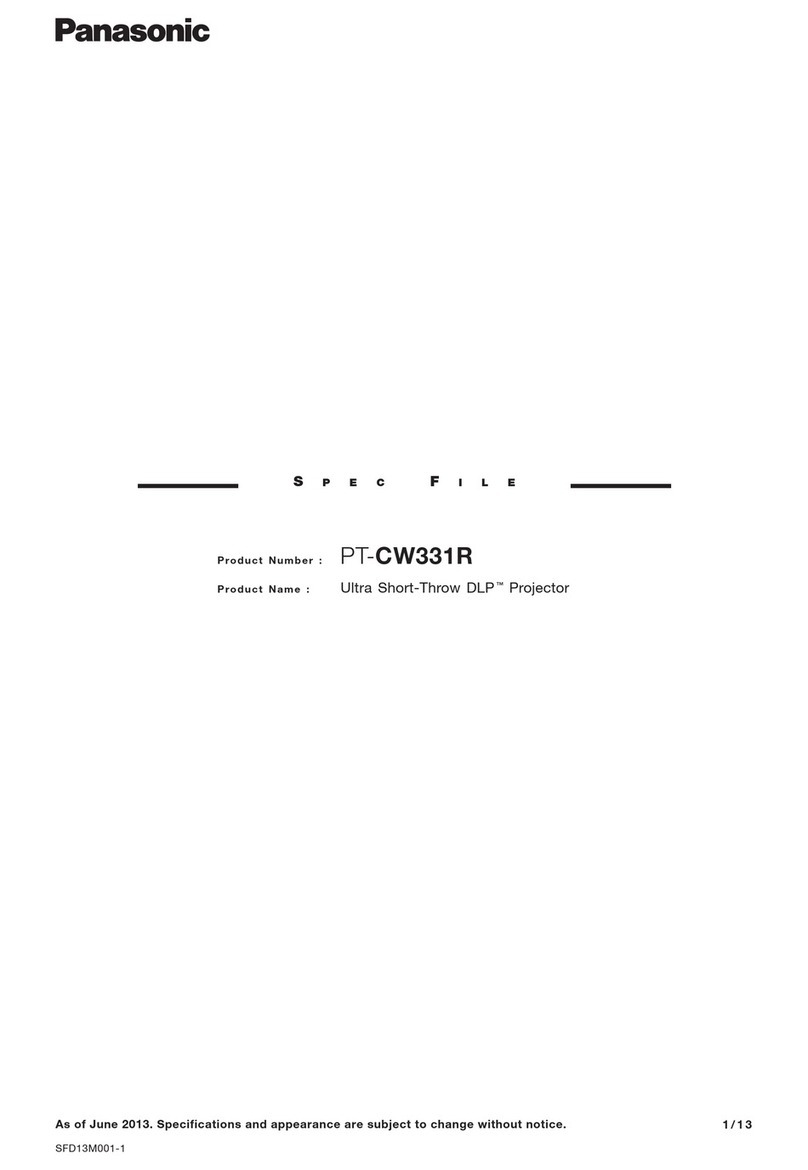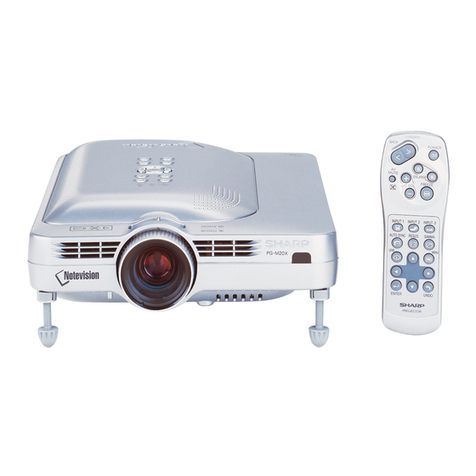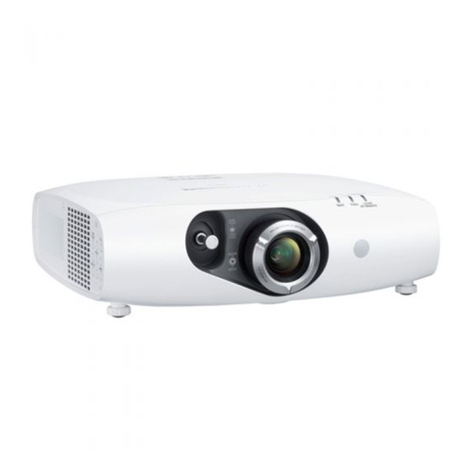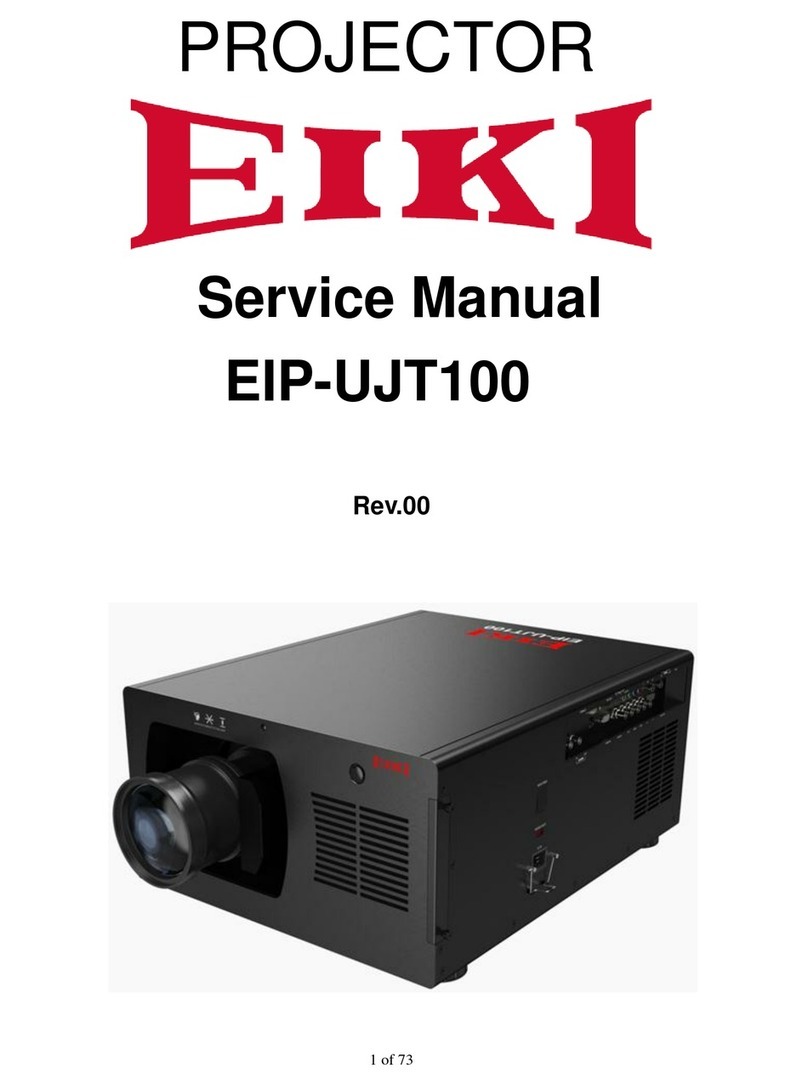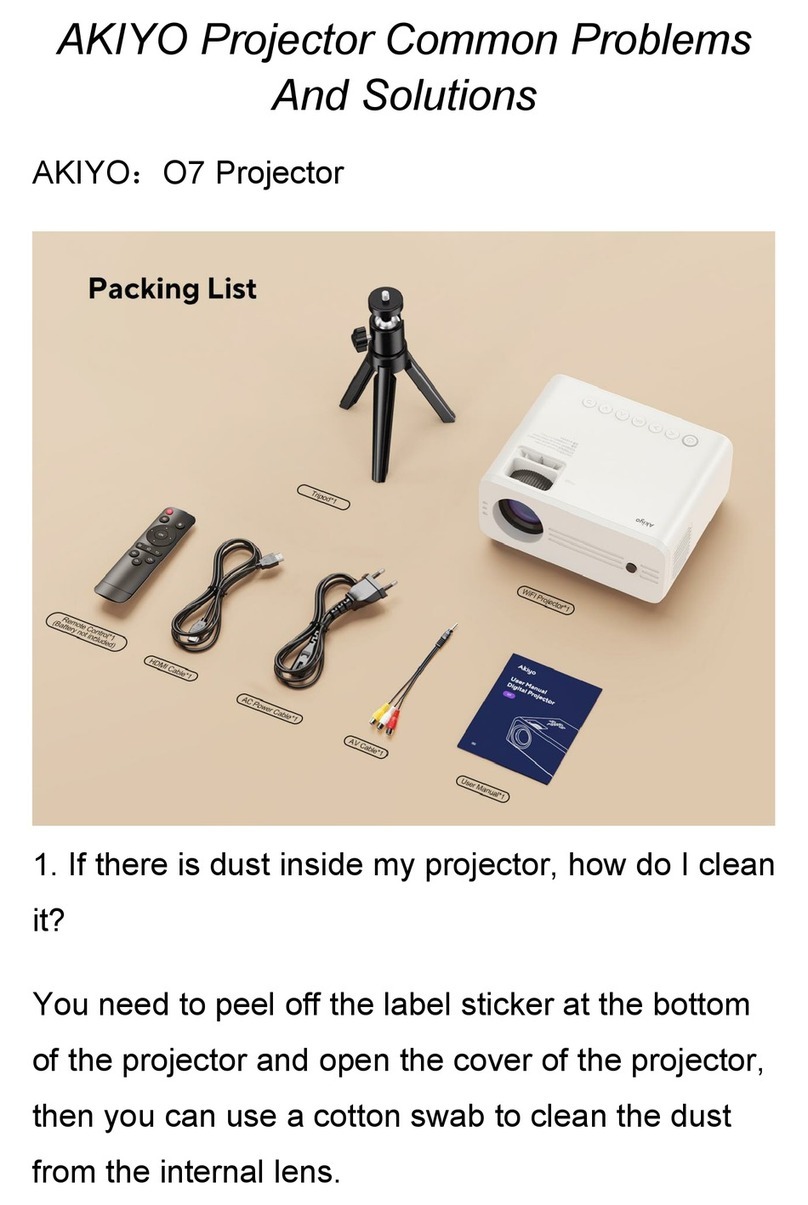STUDIODUE CITYCOLOR 2500 IP54 User manual

Safety informations........................................................................................................................... page 2
Technical features.............................................................................................................................. page 3
Before using....................................................................................................................................... page 4
Lamp installation, replacement and setting.................................................................................... page 5
Installation of the dust proof filters .................................................................................................. page 6
Control panel and configuration...................................................................................................... page 7
Programming functions .................................................................................................................... page 8
Use of the CityColor in DMX 512 ..................................................................................................... page 9
DMX signal connection..................................................................................................................... page 10
DMX line and termination ................................................................................................................ page 11
Automode functioning...................................................................................................................... page 12
Troubleshooting ............................................................................................................................... page 13
System board connection ................................................................................................................ page 15
Electric diagrams .......................................................................................................................... page 17
Components and parts...................................................................................................................... page 22
Technical drawings............................................................................................................................ page 23
Appendix A (DMX values) ................................................................................................................ page 26
Appendix B (games).......................................................................................................................... page 27
rev. 4/02.05
INTERNATIONAL PATENT WO99/40361
IP•54
ENGLISH INDEX

2
WARNING
INTRODUCTION
Thank you for using our flood projector CityColor.
TheCityColor projects,thanks toanextremely efficientoptic system(internationalpatentn.WO99/40361), apowerful lightbeamwhich
can create numberless color shades. Its performances, in terms of luminousity and lighted surfaces, can reach incredible levels.
The CityColor IP54 comes in the following versions:
• Art. 0002 CITYCOLOR IP54 1800W
• Art. 0003 CITYCOLOR IP54 2500W High Power
The CityColor can work in automatic mode or in synchro mode, otherwise may be controlled by 8 bit DMX controllers
The input protocol is the DMX 512. To drive the CityColor we suggest to use either our controller DMX Control Spot, the
Control Show 512 the Easy Control or the Fancy.
To make the most of its possibilites and for a correct functioning of this unit in the years to come, we suggest you to read carefully
this manual before connecting or putting the spot into use. By doing so you will gain experience with its commands and connections
and you will be easily able to use it.
WARNING
!SAFETY INFORMATION
READ ALL CAUTIONS AND WARNINGS PRIOR TO OPERATE THIS EQUIPMENT.
INSTRUCTION TO PREVENT INJURY OR DAMAGE DUE TO ELECTRIC SHOCK, FIRE, MECHANICAL HAZARDS AND
UV RADIATION HAZARDS.
• PROTECTION AGAINTS FIRE
1) IMPORTANT: Use only the lamps showed on page n. 3.
DO NOT USE ANY OTHER TYPE LAMP!
2) Maintain minimum distance of 0.5 meter from walls or any other type flammable surfaces.
3) Maintain minimum distance to lighted objects of 5.0 meter.
4) Replace fuses only with the specified type and rating.
5) Do not install the spot close to heat sources. Do not lay the connection cable on the spot when it is warm.
• PROTECTION AGAINST ELECTRIC SHOCK
1) This equipment must be earthed.
2) Class I equipment. The power supply cord includes a protective earthing conductor as part of the cord.
3) For connection to the supply mains proceed as pict.1 page 3. The equipment must be connected to branch circuit having a
circuit- breacker In=16A Id=0.03A (230VAC) (art.0002) or In=32A Id=0.03A (230VAC) (art.0003)
4) Disconnect power before lamp’s replacement or servicing (service personnel).
• PROTECTION AGAINST MECHANICAL HAZARDS
1) Use secondary safety chain when fixing this equipment.
2) Hot lamp explosion hazard. Do not open the equipment for 300 seconds after switching off.
3) Equipment surface may reach temperature up to 100°C. Allow about five minutes before handling.
4) Replace the lamp if it is damaged or thermally deformed.
• PROTECTION AGAINST UV RADIATION HAZARDS
1) Do not start on this equipment without lamp enclosure or if the protection screens, or ultraviolets screens are damaged.
2) The protection screens, the lenses, or the ultraviolet filters must be replaced if they are visibly damaged and their effectiveness
has been reduced, for example, by cracks or deep scratches.
3) Do not look directly at the lamp while lamp is on.
Check that the spot has not been damaged during transport. If it has been damaged or it does not work, address
the seller. Whether the spot has been shipped to you directly, please contact the shipping company.
Only the consignee (person or company) can claim for these damages.
!

3
YOUR REFERENCE
Always remember to give the serial number and to specify the model any time you address the seller for information or assistan-
ce.
BASIC KIT
The basic kit of the CityColor flood projector consist of:
•Projector
•User’s manual
•Power connector
•Studio Due warranty
Available on request:
•art. 9801/a: barndoor to define illuminated surface
•art. 0003/a: anti glare
•art. 0002/a: XLR 3 pin male IP54 connectors
•art. 0002/b: XLR 3 pin female IP54 connectors
•Lamp
TECHNICAL FEATURES
•LAMPS
MHN/SA 1800W PHILIPS (art. 9801 - 0002)
Color temperature: 5.600°K
Lamp life: 2.500 hours
Luminous flux 180.000 lm
•OPTIC COLOR SYSTEM
Full CYM color mixing, unlimited variety of colours and shades. High resolution stepper motors.
Shutter + dimmer. The color changer can be drived with 4 different speeds or in real time.
•BEAM ANGLE: (50% intensity) 50°x52°
•CONTROL INPUT
Standard interface: RS-485; opto-couplet input.
Protocol: USITT DMX 512
•SETUP AND CONFIGURATION
On the control panel with menu and buttons
•AUTOMODE
Stand-alone control: auto mode function master/slave (synchro mode) with 27 programs
•IP RATE: IP 54 (art. 0002 - 0003)
•POWER SUPPLY: (art. 0002) magnetic ballast
Rated voltage: 230V/50Hz
On request: 200V/50Hz; 208V/60Hz; 230V/60Hz; 240V/50Hz
Rated current: 10A
Rated power: 2000W
•POWER SUPPLY: (art. 0003) magnetic ballast
Rated voltage: 230V/50Hz
On request: 200V/50Hz; 208V/60Hz; 230V/60Hz; 240V/50Hz
Rated current: 14A
Rated power: 3000W
•POWER FACTOR CORRECTOR: built-in cos Ø 0.9
•DMX CHANNELS
ch1 = motors speed
ch2 = cyan
ch3 = yellow
ch4 = magenta
•DIMENSIONS (wxdxh)
mm 780x560x740
•WEIGHT
art. 0002: 56 kgs. net
art. 0003: 69 kgs. net
HTI/DE 2500W OSRAM • MSA/DE 2500W PHILIPS (art. 0003)
Color temperature 6.000°K
Lamp life 2.000 hours
Luminous flux 260.000 lm
ch5 = dimmer
ch6 = basic colors + rainbow
ch7 = remote reset/lamp off

4
CITYBEAM art. 0203
CITYBEAM art. 0203
®
SN
SN
230V ;14A-60Hz
AC
230 V;
14A -60 Hz
AC
QC
QC
Disconnectthe unit from powerbe
foreservicing
Keepatleast a distance of 0.5mt between the apparatus
andinflammablesu
rfacenearby
1800W
1800W
CITYBEAM art. 0203
CITYBEAM art. 0203
®
SN
SN
230 V ;14A - 60 Hz
AC
230 V;
14A -60 Hz
AC
QC
QC
Disconnectthe unit from power before servicing
Keepat least a distance of 0.5mt between the apparatus
andinflammable surface nearby
1800W
1800W
BEFORE USING
Read all cautions and warnings to page 1 prior to install this equipment. Particularly, read the follow:
1) Disconnect power before lamp’s replacement or servicing (service personnel)
2) Do not open the lamp cover for 300 seconds after switching off
3) Wear gloves and goggles to re-lamping or to work inside the unit (service personnel)
Before connecting the equipment to the power system: make sure that the mains voltage and frequency correspond to rated
values.
• The CityColor can be equipped for a mains voltage 230Vac, 50Hz.
on request: 200V/50Hz; 208V/60Hz; 230V/60Hz; 240V/50Hz
For a power supply of 100V-120V it is necessary to use one auto transformer with the following features:
• Output voltage 230V
• Output current 15A (for art. 0002)
• Output current 20A (for art. 0003)
The power supply cords construction is shown in pict.1. For connection to the mains supply proceed as pict.1.
The equipment must be connected to branch circuit having a circuit-breacker In=16A • Id=0.03A (230VAC) (art. 0002) or
In=32A • Id=0.03A (230VAC) (art.0003)
a) Do not install the spot close to the heat sources. Observe minimum distance between the spots of 1.5 meters. Do not lay the
connection cable on the spot when it is warm.
b) This unit must be positioned as to allow its ventilation. Be careful not to acclude the in-out ventilating grilles.
c) The unit must be positioned at least 50cm. from walls or other flammable surfaces.
d) Observe minimum distance to lighted objects of 5 meters.
External surface temperature Ta 35°C:
• After 5 minutes work; Tc=75°C.
• Once the thermic balance has been obtained; Tc=100°C.
4) The protection screens, the lenses, or the ultraviolet filters must be replaced if they are visibly damaged and their effectiveness
has been reduced, for example, by cracks or deep scratches.
5) The lamp must be replaced if it has been damaged or thermally deformed.
6) Clean regularly the in-out ventilating grilles.
7) Do not handle the spot by taking it by the head, but always by using the special handles.
WARNING
!
IP 67 pict.1
The equipment must be earthed.
IP 54 rate: the equipment must be installed on the horizontal plane.
INPUT CONNECTOR
FOR 1800W
INPUT CONNECTOR
FOR 2500W HIGH POWER
IP 67
3 PIN CONNECTOR FOR POWER INPUT
N = NEUTRAL
L = LIVE
= GROUND
CONDUCTOR SIZES (length < 20mt.)
MAINS VOLTAGE CROSS SELECTIONAL AREAS
230V 3X1,5 mm2(minimum)
CIRCUIT BREAKER
MAINS VOLTAGE In Id
230V 32A 0,03A

5
C
D
E
C
INSTALLATION OF THE DISCHARGE LAMP (art. 0002 - 0003)
(see pic.2)
1) Disconnect power before lamp’ s replacement. Wear gloves and goggles.
2) Remove completely the pommels (A) on the base of the head
3) Open the base of the lamp room (G)
4) Remove the two lateral reflectors (C)
5) Lift up the two lampholder (D)
6) Install the new lamp. Taking care that protuberance of the bulb is set towards the reflector
Do not touch the quarz bulb with fingers. If this happenes, clean the bulb before use with dry cloth and alcohol.
7) Put down the two upper lampholders (D)
8) Connect the cables (E) to the two ends of the lamp or connect the two cables of the lamp to the two red insulators on the rear
panel of the head.
9) Put in again the two lateral plane reflectors.
10)Close the rear panel and install again the two pommels (A) and hold them tightly.
In case of replacement of the lamp or maintenance, do not open
the fixture unless 5 minutes have passed from the switching off.
This operation has to be done when the apparatus is disconnected
from the mains supply
WARNING
!
pict.2
A
G

6
pict.3
WARNING
!
IP RATE
The declared IP rate of the CityColor comes supported at these conditions:
• the installation of the fixture on a wide and stable surface
• the air cooling input and output are located on the base of the side-shell,
it is not possible to install the fixture outdoor with the ballast upwards
• you must use the filter supplied with the basic kit for the IP RATE 54
The CityColor has a IP rate 44 without filters installed and an IP RATE 54 with filters installed.
You must use the filters in critical working conditions and, normally, when the fixture works outdoor.
You must remove the filters when the ambient temperature is over 35°C.
You must regularly clean the filters to allow the correct cooling of the fixture.
You must remove the two side protective shells. The
two filters must be assembled on the bulkheads at the
bottom of the side brackets.
Pay attention to the installation: dust proof filters
must stick correctly to prevent the entrance of the
dust. You must control that the two filters comple-
tely cover the overall of the air entrance.
INSTALLATION OF THE DUST PROOF FILTERS
WARNING
!You must operate with power supply disconnected from the fixture

7
pict.4
CONTROL PANEL
On the control panel of the CityColor (pict.4) you can find, besides the display, the leds and the buttons to use to set the spot.
LED
• “DMX” led flashing: DMX input present
off: no DMX input
• ”LAMP” led flashing: the lamp switching off is remotely controlled
off: lamp switched on
• ”DIMMER” led flashing: the lamp is 33% dimmered
off: lamp switched on
BUTTONS
Four buttons are used to programme the spot:
• MENU to select the programming options
• DOWN to go backward in the selected options
• UP to go forward in the selected options
• ENTER to confirm the selected options
DISPLAY
Shows the various menus and the selected options.

8
About twenty seconds after the switching on, the number of the software version will be shown on the display in “X_00” format.
Afterwards the first of the eight available menus will appear:
Addr to assign the DMX-512 address
Mode DMX512 mode, master with pre-set selection, slave
LHrS lamp working hours
FHrS fixture total working hours
nChn channels number
teSt auto-test
FLIP display inversion
rSEt reset of the spot
To select any of the given options, press the MENU button up to when the required one is shown.
Addr (Address)
To visualise the DMX address press ENTER.
Tomodify theaddress pressDown andUp buttonsand,oncetherequired addresshas beenselected, press and keepENTER pressed
up to when the display stops flashing (it flashes to indicate that the selected option is different from the pre-set one). To go back to
the options without making any change, press the MENU button.
Mode (Mode)
To visualise this mode press ENTER.
Use Down and Up buttons to change the mode and, once the required one has been selected, press and keep ENTER pressed up
to when the display stops flashing (it flashes to indicate that the selected option is different from the pre-set one). The available
options are: no (normal) for the functioning in DMX reception; Pr01…Pr15 (pre-set 01…15) for the master functioning with the re-
spective game, SL (slave) for the functioning as slave. To go back to the options without any change, press the MENU button.
LHrS (Lamp Hours)
To visualise the number of working hours of lamp press ENTER.
The maximum countable number of hours is 3000. Exceeding this number, the display will show gr3t (greater than 3 thousands).
To reset the counter press simultaneously buttons Down and UP: the display will show CLLH (clear lamp hours). To go back to the
options without making any change, press the MENU button.
FHrS (Fixture hours)
To visualise the number of working hours of fixture press ENTER.
The maximum countable number of hours is 3000. Exceeding this number, the display will show gr3t (greater than 3 thousands). To
reset the counter press simultaneously buttons Down and UP. A control of the memory will be run and all the default settings will be
stored: the display will then show Init. If the memory is damaged, the display will show the message FAIL. To go back to the options
without making any change, press the MENU button.
Addr nChn
teSt
FLIP
rSEt
Mode
LHrS
FHrS
SUMMARY OF THE PROGRAMMING FUNCTIONS OF THE CITYCOLOR

9
WARNING
!
DRIVING THE CITYCOLOR WITH A DMX REMOTE CONTROLLER
• Select the requested DMX starting address by operating on the Addr option
• Select the requested number of channel with NChn option
• Connect the DMX signal between the fixture and the controller
• Check that the DMX led is flasing. (DMX signal present)
• If there is no signal, you must manually reset by operating on the RESET option
It is possible to choose a standard configuration occupying 6 DMX channels, or a enanched configurationoccupying 7 channels.
Use the enanched configuration if you want to activate channel 7 which enables the reset of the motors and the switching off of
the lamp from the controller.
6/7 CHANNELS MODE SELECTION
Press the MENU button on the control panel up to when the option nChn is shown on the display, select it by pressing ENTER
and the set indication will appear (6 or 7 channels). If you want to activate channel 7 you must set 6 channels on the display. Pass
through the numbers by pressing the buttons UP and DOWN: once you have set the required number, store it by pressing the
ENTER button and keep it pressed up to when the display stops flashing (the flashing shows that the selected option is different
from the one previously stored). To exit from the selected option without making any change press the MENU button.
Here below is shown the complete list of the functions of the CityColor.
The complete list of the DMX values can be found in appendix “A”, page 26
7 CHANNELS 6 CHANNELS
CH 1= Motor speed CH 1= Motor speed
CH 2= Cyan CH 2= Cyan
CH 3= Yellow CH 3= Yellow
CH 4= Magenta CH 4= Magenta
CH 5= Dimmer CH 5= Dimmer
CH 6= Basic colors+rainbow CH 6= Basic colors+rainbow
CH 7= Remote reset/Lamp off
nChn (Number of Channel)
To visualise the number of channel press ENTER.
Use Down and Up buttons to change the channel and, once the required one has been selected, press and keep ENTER pressed
up to when the display stops flashing (it flashes to indicate that the selected option is different from the pre-set one). It is possible
to set 6 channels or 7 channels ( remote reset and remote lamp switch off ). To go back to the options without making any change,
press the MENU button.
teSt (Autotest)
To insert the auto-test press ENTER and keep it pressed up to when the display shows the flashing message t-on (test on). To take
off the auto-test press the MENU button. To go back to the options without making any change, press the MENU button.
FLIP (Display overturning)
The display visualisation can be standard or overturned: by pressing the ENTER button the two modes will be alternatively visible.
The selected one will be immediately stored in the spot setting.
To go back to the options without making any change, press the MENU button.
rSEt (Reset)
To run the complete reset press ENTER and keep it pressed up to when the display shows the flashing message r-on (reset on).
Once the reset procedure has been completed the spot will go back to the normal setting. To go back to the options without mak-
ing any change, press the MENU button.
When using CYM color mixing, the basic colors channel # 6 must be set at: 00=DMX value

10
pict.5
pict.5a
CONNECTION THE DATA LINK (DMX 512)
The connection of the DMX signal to the CITYCOLOR must be made by using the signal input XLR 5 pin connectors which are located
on the control panel of the fixture. (pict.5)
The pin nomenclature of the connectors for the connection to the DMX signal is listed in the table. (pict.5a)
In order to avoid any problem in the signal transmission, it is warmly suggested to use a cable for high speed data transmission
(sect. > 2x0.25 + gnd).
If the lines have a total length over 150-200 mts it is suggested to use a signal amplifier (art. 3004 - DMX repeter amplifier).
The usage of a normal microphonic or audio cable is suggested only for lines max 100 mts long.
To ensure the IP54 rate you must connect the DMX cable inside the base. Use the given cables fixing (pict. 5b) and connect by
following the cables numbering (pict. 5c).
fig.5c
fig.5b
PIN WIRE SIGNAL
1 SHIELD GROUND/RETURN/OV
2 INNER CONDUCTOR DATA COMPLEMENT (-, INVERTED)
3 INNER CONDUCTOR DATA TRUE (+, NON INVERTED)

11
TERMINAL RESISTOR
DMX CONTROLLER OR LIGHT
CONSOLE
TERMINAL RESISTOR
LAST SPOT
SPOT
EXAMPLE 2
Connection controller-spot to one DMX 512 output over 150mts long
SIGNAL AMPLIFIER
LINE > 150mts (with microphonic or audio cable)
DMX TERMINAL LINE
Thewrong connection ofthe terminalline orits non-connectionare probablythe most frequentreasons forthe defectivefunctioning
of the DMX line. The terminator is a resistor fitted between the two “data” lines (pins 2 and 3 of an XLR 5 pin connector) at the end
of the cable furthest from the transmitter. The terminator resistor should have the same value as the impedance of the connection
cable.
We supply a terminal with a 100 Ohm resistor.
It is recommanded that all DMX 512 systems have the termination resistor at the and of the line.
DMX CONTROLLER OR LIGHT
CONSOLE
EXAMPLE 1
Connection controller-spot with 1 DMX 512 output
LAST SPOT
SPOTSPOT SPOT
WARNING
!
pict.6
TERMINAL RESISTOR

12
The cables are the same as the DMX standard cable
WARNING
!
MASTER
USE OF THE CITYCOLOR IN AUTO-MODE
A short list of the games can be found in appendix “B”, page 27
Press the MENU button on the control panel up to when the option MODE (pict. 7) is shown on the display, select it by pressing
ENTER and the set indication will appear (no...SL). Use Down and Up buttons to change the mode and, once the required one has
been selected, press and keep ENTER pressed up to when the display stops flashing (it flashes to indicate that the selected option
is different from the pre-set one). The available options are: no (normal) for the functioning in DMX reception; Pr01…Pr27 (pre-set
01…27) for the master functioning with the respective game, SL (slave) for the functioning as slave.
To go back to the options without any change, press the MENU button.
Mode no use of the CityColor in DMX-512
Pr1..Pr27 master functioning with execution of the 27 stored programme
SL use of the CityColor in SLAVE MODE
pict.7
EXAMPLE OF CONNECTION AND SETTING OF 4 CITYCOLOR IN SYNCHRO - MODE
EXAMPLE OF CONNECTION AND SETTING OF 4 CITYCOLOR IN INDIPENDENT AUTO - MODE
MASTER SLAVE SLAVE SLAVE
MASTER MASTER MASTER MASTER

13
GENERAL TOUBLESHOOTING
Appendix “C” • Table A1
TROUBLESHOOTING GUIDE
Before calling for technical assistance, follow the recommended procedures in this appendix to solve many problems on your fix-
ture.
CAUTION! • BEFORE YOU BEGIN:
Before you perform any troubleshooting procedures read the following personnel and equipment safety precautions:
1) Refer servicing to service personnel (Q.T.= qualified technician); no user serviceable parts inside
2) Wear hand and eye protection
3) Wait at least five minutes before accessing the lamp after operation
4) Disconnect the unit from power before removing any cover (Q.T.)
If the procedures do not solve your problem and you need to call for assistance, please provide the support technician with the
follow information:
• Customer name
• Phone number and fax number
• Fixture serial number
• Message that are you displayed on your Citycolor display
• Description of the problem and the troubleshooting procedures that you have performed so far to diagnose and resolve the
fault.
You can contact your authorized STUDIO DUE dealer or directly STUDIO DUE Technical Service.
14

14
DATA LINK (512 DMX) TOUBLESHOOTING
Appendix “C” • Table A2
14

15
MAIN BOARD CONNECTION
LED
320V DC
LED +5V U3 MICRO MASTER MOTOR
CC3DRVXX
U4 MICRO SLAVE MOTOR
CCSLAVEXX
LED +28V
TO BASE FAN
TO HEAD FAN
VRI VARISTOR 275V
(OVERVOLTAGE PROTECTION)
MOT2
DIMMER
MOT5
CYAN
U12
7805
+5V
TO HEAD
THERMAL SENSOR
AND SWITCH
MAIN POWER
INPUT
TO CC250
TO PCB
CC250
MOT4
YELLOW
U5 U6 U7 U8 U9 L6219 MOTOR DRIVER
U10 MICRO PWM
FAN CONTROLLER
MOT3
MAGENTA
TO LAMP BOX, CYM BOX
SAFETY SWITCH
LED DMX
SIGNAL
LED +5V OPTO DMX
U13 78M05
OPTO DMX
TO DISPLAY
PCB PAN IP
U11 VIPER SWITCHING
POWER SUPPLY DRIVER
C65
D3
D1 OFF LINE BRIDGE
RECTIFIER

16
MOTORS BOARD
• POWER SUPPLY +30V Led On
• +5V Led
• +320V Led
•+5V DMX Led
• DMX signal
Led flashing: the DMX signal is operating on the board
Led off: check the U1 (6N137) and the DMX connecting cable (from PCB PAN IP)
• STEPPER MOTOR channel not working: (i.e. YELLOW):
1) Switch off the fixture and disconnect the YELLOW and CYAN cables
2) Connect the YELLOW cable on the CYAN connector
3) Switch on the fixture:
3a) If the YELLOW motor works normally it is necessary to replace the U6 (L6219)
3b) If the motor is still not working check with extreme attention the motor and the interconnecting circuits (cables and
connectors). To check the cables and the motors you can measure the resistance as follows:
between PIN 1 and PIN21 (on IC U6)r=~18ohm; between PIN 2 and PIN5 (on IC U6) r=~18ohm
• If the led +5V OPTODMX is off:
1) Disconnect TO DISPLAY PCB PAN IP connector; if the led is on check PCB PAN IP
2) Check U13 (78M05), L3, D6
• If the led +5V is off:
1) Disconnect TO DISPLAY PCB PAN IP connector; if the led is on check PCB PAN IP
2) Check D4, L2, U12
•If the led +28V is off:
1) Check if the led +320V is on, if it is ok:
1a) Check if U11 is in thermal drift (ATTENTION on the heat dissipator there is dangerous tension!!!!)
1b) Check if U5, U6, U7, U8, U9 are in short-circuit. Switch off the fixture. Remove all the chips from the socket.
Switch on the fixture: if the led is on, insert the chips one by one in the sockets to find out which is in short-circuit.
1c) Check D3
1d) If all the operations described above have not given any positive result, change U11
2) If the led +28V is off together with the led +320V
2a) Check the MAIN POWER INPUT where you can measure the working voltage
2b) Check the main fuse, if it is blown check VR1 (normally it has a resistance = ∞). If it is in short circuit you must change it.
2c) Check D1 (Bridge Rectifier), if it is ok check C65.
2d) If the fuse is still blown, change U11
Table of contents
Other STUDIODUE Projector manuals
